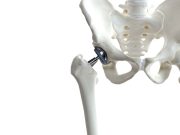Tag: Artificial Hips
Study IDs Predictors of Biomechanical Function in Patients With OA Undergoing Hip Replacement
Radiographic osteoarthritis severity best predictor of preoperative biomechanical function, while preoperative muscle fat fraction best predictor of postoperative function
Birmingham Hip Resurfacing Safe, Effective Over 15 Years
15-year survivorship free from any revision and from aseptic revision was excellent, at 96.0 and 97.4 percent, respectively
Total Hip Replacement Revision Rates Vary With Type of Material Used
Lowest risk seen for implants with delta ceramic or oxidized zirconium head and HCLPE liner/cup
THA Superior to Resistance Training for Reducing Hip Pain, Improving Function
Hip replacement better than resistance training among patients aged 50 years or older with severe hip OA, indication for surgery
Joint Infection After Hip Replacement Tied to Fivefold Higher Risk for Death Over 10...
Authors say findings highlight the need for infection prevention
Infection Risk No Higher for Total Hip Arthroplasty With Robotics, Navigation
Despite longer operative times than conventional THA, no increase seen in periprosthetic joint infection
Total Hip Arthroplasty Can Be Performed Safely in 90-Year-Olds
Comorbidities tied to higher rates of complications and postoperative morbidity
Total Hip Arthroplasty Safe for HIV-Positive Patients
Postoperative variables, including rates of pneumonia, wound dehiscence, surgical site infection, no different in matched analysis
Guidance Issued for Optimal Timing of Knee, Hip Total Joint Arthroplasty
Conditional recommendations include not delaying surgery to pursue additional nonoperative treatments
Intraoperative Staff Turnover Linked to Procedural Inefficiency
In total knee arthroplasties, decrease in procedure time, room time seen with presence of preferred anesthesiologist or surgical technician














